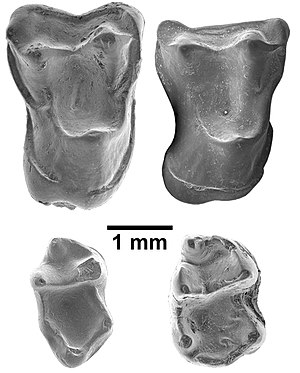Afrasia
| Afrasia | ||||||||||
|---|---|---|---|---|---|---|---|---|---|---|

The four teeth of Afrasia djijidae |
||||||||||
| Temporal occurrence | ||||||||||
| Lower Priobonium , Upper Eocene | ||||||||||
| radiometrically dated to ≈37 million years | ||||||||||
| Locations | ||||||||||
| Systematics | ||||||||||
|
||||||||||
| Scientific name | ||||||||||
| Afrasia | ||||||||||
| Chaimanee et al. 2012 | ||||||||||
| species | ||||||||||
|
||||||||||
Afrasia is a genus of primates from the extinct family of Afrotarsiidae . The absolutely dated, around 37 million year old fossil remains from the lower Obereocene were discovered near the town of Myaing in Myanmar and described scientifically for the first time in 2012 by an international group of researchers.
Naming
Afrasia is an artificial word . The name refers to the distribution of the relatives of this genus (the suborder Eosimiiformes) in Africa and Asia . The epithet of the type species afrasia djijidae reminds loud first description "to a young girl from the village of Mogaung in central Myanmar." Afrasia djijidae is currently the only described type of the genus Afrasia .
Initial description
The holotype of the genus and at the same time the type species Afrasia djijidae are, according to the first description, four large molars , which are closely related to the structure of the teeth in the similarly old species Afrotarsius libycus ; Afrotarsius libycus occurred in Africa ( Libya ) and is also only occupied by a few molars. In both types, the upper jaw teeth are almost identically shaped. Due to the small size of the teeth, it was estimated that the animal could have weighed around 100 grams.
The four teeth from Myanmar were recovered from several tons of sediment over the course of six years and interpreted in the first description of the genus and species as evidence that the ancestors of the "real apes" (the Anthropoidea) originated in Asia and from there around 40 Migrated to Africa millions of years. In an accompanying article, however, this interpretation was rejected as too far.
Individual evidence
- ↑ Yaowalak Chaimanee et al .: Late Middle Eocene primate from Myanmar and the initial anthropoid colonization of Africa. In: PNAS . Volume 109, No. 26, 2012, pp. 10293-10297, doi: 10.1073 / pnas.1200644109
- ^ Fossil discovery sheds new light on evolutionary history of higher primates. On: eurekalert.org of June 4, 2012
-
^ Richard F. Kay: Evidence for an Asian origin of stem anthropoids. In: PNAS. Volume 109, No. 26, 2012, pp. 10132-10133, doi: 10.1073 / pnas.1207933109
An Asian Origin for Human Ancestors? On: sciencemag.org from June 4, 2012